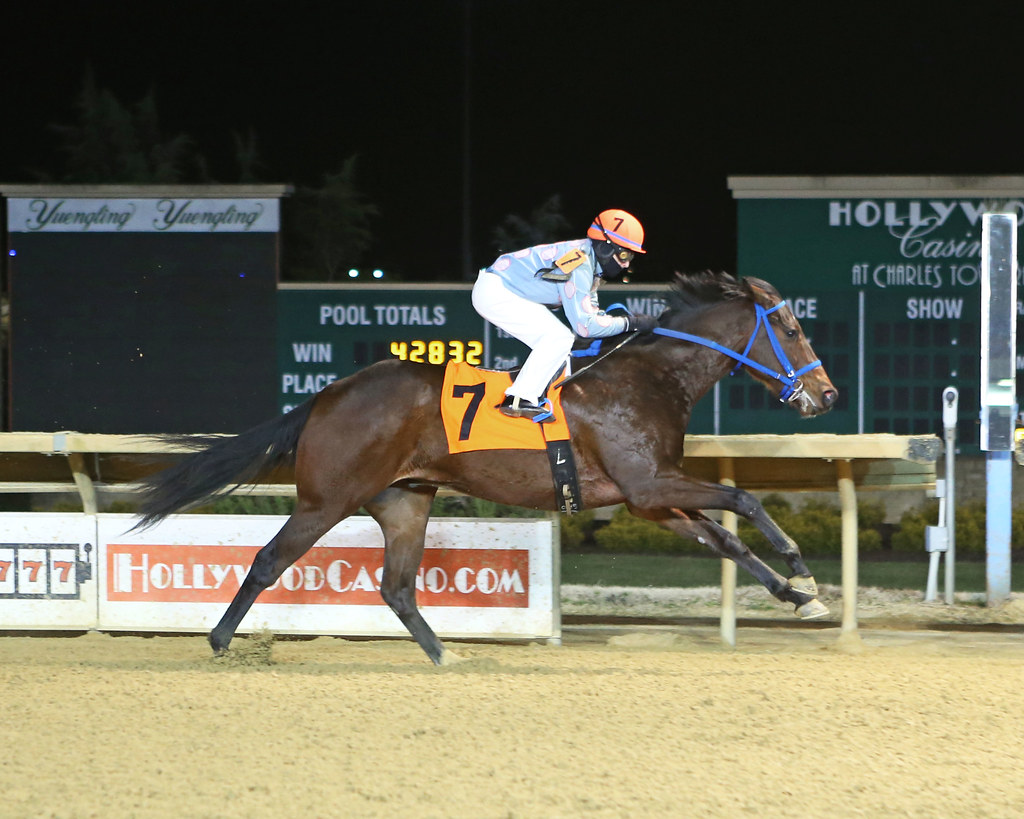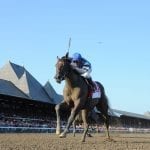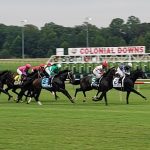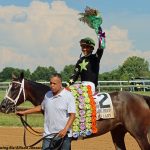ISHIHARA, MISSIONSNINETYNINE POST DEBUT WINS

In the span of an hour January 8 at Charles Town Races, a pair of West Virginia-bred three-year-olds prevailed in their respective debuts at different distances while displaying dramatically different tactics.
Nearing the midway portion of the Friday night card, Ishihara and Missonsninetynine both scored at first asking in maiden special weight events for state-bred three-year-olds.
Ishihara, a sophomore son of Creative Cause trained by Jeff Runco for owner-breeder Huntertown Farm LLC, bided his time through the early stages under Arnaldo Bocachica before getting up late to score by three parts of a length under confident handling in a two-turn event. Two races later Missionsninetynine and Gerald Almodovar darted to command between horses early en route to a five-length score in a one-turn dash for owner-breeder-trainer James W. Casey.
Ishihara went postward as the 3-5 favorite in a 6 1/2-furlong contest, and he lived up to that billing while being handled confidently in the lane despite a tepid advantage.
“We thought he would run a big race,” Runco said of Ishihara, named for the test that reveals the type and seriousness of color vision deficiencies in humans.
“I thought he was coming into his first race pretty good. He really has a little more speed than he showed the other night. He was a little slow from the gate, but he got right up toward the leaders down the backside. I thought Arnaldo rode him with a lot of confidence. Even in the lane he didn’t really get after him. We’ll see how good he is. We’ve got time to find another race and find out.”
- Spa Selections 2025: Saratoga Picks July 10
 Picks and analysis for today’s key races from Saratoga.
Picks and analysis for today’s key races from Saratoga.
Ishihara had worked three times in October at three furlongs each, then four times in November all at four furlongs. His first workout in December was a five-furlong move in 1:01.20, followed by a sharp half-mile move in 48.40, which was third best among 63 runners at the distance that morning.
In his debut last Friday, Ishihara got away in fourth, steadily advanced down the backside and through the far turn, surged to command and edged past Candy Invasion for nearly a length score in 1:29.02 for the seven panels.
An hour later Missionsninetynine darted to a five-length victory as a moderately backed 4-1 shot in a one-turn, 4 ½-furlong contest. A sophomore son of Super Ninety Nine out of a Warrior’s Reward mare owned, bred and trained by James W. Casey, Missionsninetynine scored at first asking by getting clear in the lane to a five-length triumph over 7-5 favorite Entry Time.
Missionsninetynine covered the 4 1/2-furlongs in 53.05.
“I thought he looked pretty good,” Casey said. “Once he made the front down the backside, he was going pretty good. Then turning for home, he just seemed to be moving easily.”
On paper, Missionsninetynine had come into his debut following a series of modest workouts, five in the six weeks prior to the race. He had two three-furlong drills in November and headed into his debut off a trio of half-mile works, the fastest of which went in 48 2/5 seconds December 11; that was the second-fastest of 17 at the distance.
- CT: It’s all about the finish for Xcellent Start
 Claimed earlier this year, the inaptly named, late-running Xcellent Start may be nearing a return to stakes company for trainer Wade Sanderson.
Claimed earlier this year, the inaptly named, late-running Xcellent Start may be nearing a return to stakes company for trainer Wade Sanderson.
“I thought he had displayed some ability in his workouts, but you never really know until they run,” Casey explained. “They always look better when they make the front and get to the rail early rather than taking back and having to pass other horses. You just have to have luck in this business.”
Missionsninetynine proved to be even better under the lights in his debut last Friday night and gave Casey another reason to be optimistic about his future. Casey, who continues into his 80s to play a major role in the state’s Thoroughbred industry, stands four stallions at his Taylor Mountain Farm, including the popular newcomer Juba, who has seen the most mares of any stallion in the state, according to the Jockey Club’s report of mares bred.
“I’ve had a couple of first-time winners in the last month,” Casey said. “I didn’t have as many two-year-olds last year as I did in recent years. But I think the [statewide] foal crop is going to go back up next year. I think it was only at 250 last year. But there should be a few more next year and the year after that.”
LATEST NEWS














